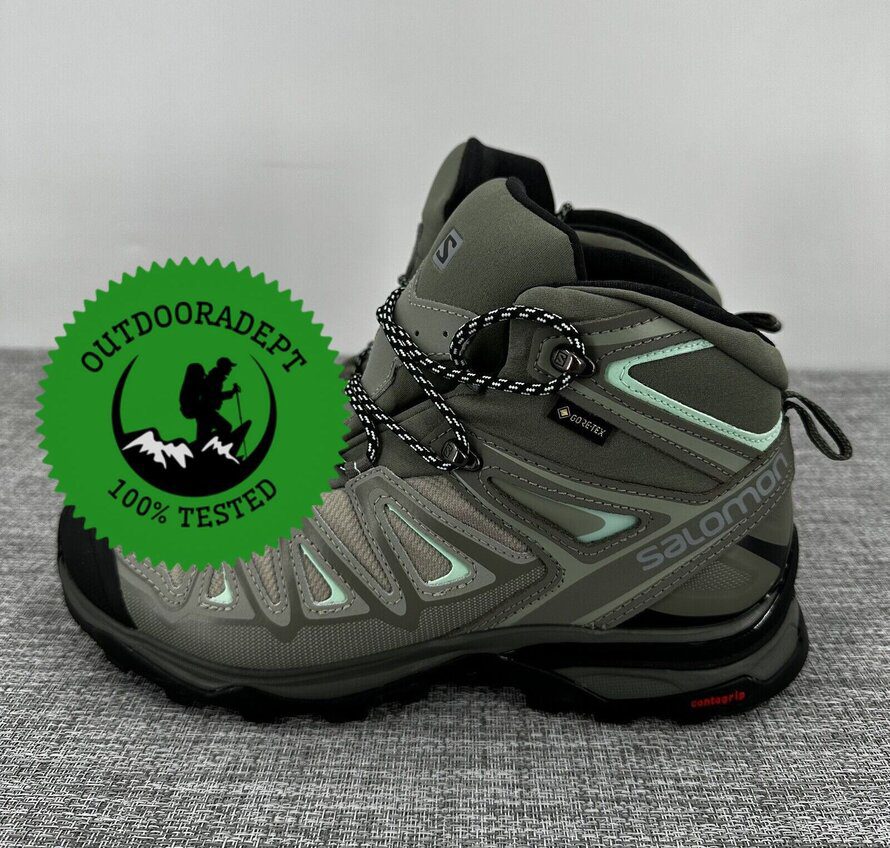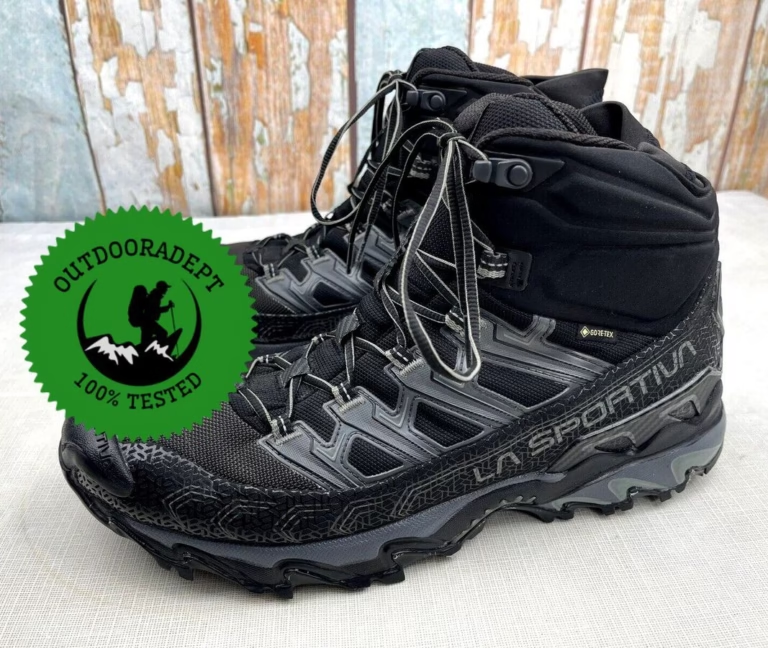Ever wondered how boots hold up on a long hike? Trying them out in a store only gives you a glimpse. You truly learn their quality when you hit the trail. We’ve done that legwork for you.
We handpicked and rigorously tested the top beginner hiking boots of 2025. We evaluated them based on criteria crucial for new hikers.
Remember, the ideal beginner boot can vary greatly depending on your individual needs as a hiker. Pay close attention to find the boot that aligns with your vision of the perfect hike.
The Verdict – Our nr. #1 Pick
From my personal experience with this model, it works great in wet conditions and uneven terrain, with an outer fabric that dries as you walk.

Based on our experience with all the products on the list, we believe the Salomon X Ultra 3 Mid GTX are the best hiking boots for beginners. They suit many types of hikers.
No matter what type of short trails or mountains you want to try out in any weather conditions, these beginner hiking boots will help you get there in comfort.
With almost no compromises—except for a weakness on expert mountain hikes—any beginner would do well with a new pair of these sturdy boots.
To determine the best 9 hiking boots for beginners, we assessed 14 different pairs throughout the United States and Southeast Asia. We put each pair through rigorous testing on various terrains, including flat, rocky, muddy, and gravel paths. Key factors like waterproofing in rainy conditions, breathability in warm weather, and insulation in snowy environments were closely examined. Our team conducted extensive, multi-day tests, enhanced with insights from independent experts, to understand the ease of breaking in these boots. We rated the boots on aspects crucial for beginners, such as fit, comfort, tread, and breathability. After compiling the average scores and considering external feedback and warranty offers, we crafted our final recommendations.
Our Top Recommended Hiking Boots for Beginners
1) Salomon X Ultra 3 Mid GTX
Best Overall Hiking Boot for Beginners
With a high-quality rubber outsole and the Descent Control Technology that provides both comfort and stability during descents and on more technical terrain, the Salomon X Ultra 3 Mid GTX boots are viable for just about any hiking.

These hiking shoes come with a highly dependable Gore-Tex waterproof lining. It offers superb resistance against water in wet conditions.
Their thick cushioning does a great job of keeping your feet warm in winter. However, you might experience some sweating in warmer weather.
I found slipping these boots on and off quite effortless. This was true even for someone with wider feet like myself. The X Ultra 3 Mid GTX offers excellent ankle support, making it well-suited for uneven or rugged terrain.
The likelihood of twisting an ankle in these boots is quite low. Additionally, the lacing system is smooth and doesn’t get stuck, based on my experience.
Balancing the needs of trail running and more demanding activities, the Salomon X Ultra 3 Mid GTX boots strike the perfect balance for both trail and hard surface use. This ranks them among the top hiking shoes for beginners.
For more information, check our Salomon X Ultra 3 Mid GTX review.
PROS
CONS
2) Merrell Moab 2 Mid WP
These boots were super easy to break in and perfect for day hiking too. The mesh and pig suede leather upper is resistant yet breathable and comfortable.

The “WP” in Merrell Moab 2 Mid WP signifies waterproof, a key feature that makes these boots a great choice. They’re equipped with one of the best Gore-Tex liners available.
Despite being made of tougher materials, these boots are surprisingly light, thanks to the Vibram rubber outsole known for its exceptional traction. This made walking on rocky or slippery terrains quite comfortable.
Be aware that these waterproof hiking boots can feel a bit stiff over long distances, so it’s wise to allow sufficient time to break them in. In my tests, I started feeling some discomfort in my heel after about four miles of gentle hiking.
However, these boots offer excellent arch support right out of the box. If you typically use additional supports, you might want to try these boots without them at first.
See full product performance by checking the Merrell Moab 2 Mid WP review.
PROS
CONS
3) KEEN Targhee III Mid WP
These boots have a super roomy toe box and an efficient lace system that makes them a good fit for either wide feet or narrow feet.
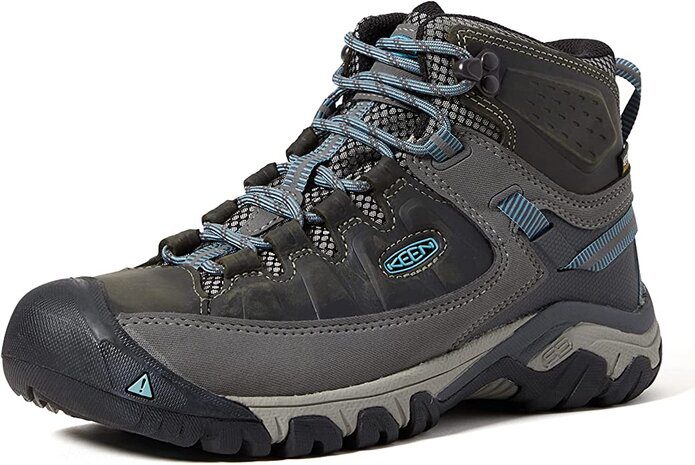
Keen is renowned for crafting some of the finest women’s hiking boots, and their KEEN Targhee III Mid WP is a testament to this.
In our testing, we were impressed with the immediate comfort these trail shoes provided. They were cozy even with thick socks, and I experienced minimal rubbing on a moderate-length hike right out of the box.
However, on uphill trails, I noticed my ankle moving more than I would have preferred.
These mid-ankle boots make medium to long hikes effortless, thanks to their exceptionally soft soles. Additionally, while they are waterproof, their breathable mesh lining ensures your feet stay cool, even during extended hikes.
To learn about this product, check the Keen Targhee III Mid WP review.
PROS
CONS
4) Vasque Breeze Lt GTX Mid
The synthetic mesh uppers are comfortable on long hikes, and the padded collar offers extra support for the ankles.

The Vasque Breeze Lt GTX Mid blurs the line between hiking shoes and trail running shoes in a way that few companies have before.
After putting them to the test, these hiking boots proved to be remarkably light, even lighter than an ordinary trail running shoe pair. But as I got closer to the end of the run, I noticed a bit of discomfort on my heel from thick stitching along the back of the boot.
The good news, though, is that once you get used to them, these can easily turn into the right hiking boots for longer hikes.
PROS
CONS
5) Columbia Crestwood Mid Waterproof
These boots have a lower rise than any other on this list which could be to your benefit or not depending on how you hike.

Moreover, these rank among the top waterproof hiking boots with a mid-cut height.
Their upper, crafted from leather, webbing, and mesh, efficiently repels water. Combined with the Omni Tech breathable membrane, they offer solid protection on wet trails.
In my experience, the mid-rise design of these boots provided great comfort on shorter and flatter hikes, which is mainly how we conducted our tests and the recommended usage for these boots.
But, be mindful that if you take these walking boots on steeper inclines, particularly under heavy loads, they might provide less ankle support than you might expect.
PROS
CONS
6) Lowa Renegade GTX Mid
With a big ankle guard and lots of cushioning, the Lowa Renegade GTX Mid is a great pick for the beginner hiker about to kick up the difficulty of their trails and scaling surfaces.

These boots are the epitome of heavy-duty footwear. They rank among the best in their category for padding, offering superior ankle and heel support.
Interestingly, thanks to their polyurethane midsole, these boots are lighter than many others of similar size.
Lowa takes pride in designing both their men’s and women’s hiking shoes with human anatomy in mind, claiming a sock-like fit. From what we’ve experienced, the boots live up to this promise, ensuring foot protection, remarkable stability, and comfort that lasts all day.
The only drawback we noticed is that the soles are a bit too flexible for adequate protection on rocky and uneven terrains, making these boots more suited for simpler trails.
Check out the Lowa Renegade GTX Mid review to discover more information about this item.
PROS
CONS
7) Danner Mountain 600
This pair of high quality hiking boots also has one of the snuggest heel fit even among more expensive mountain boots.
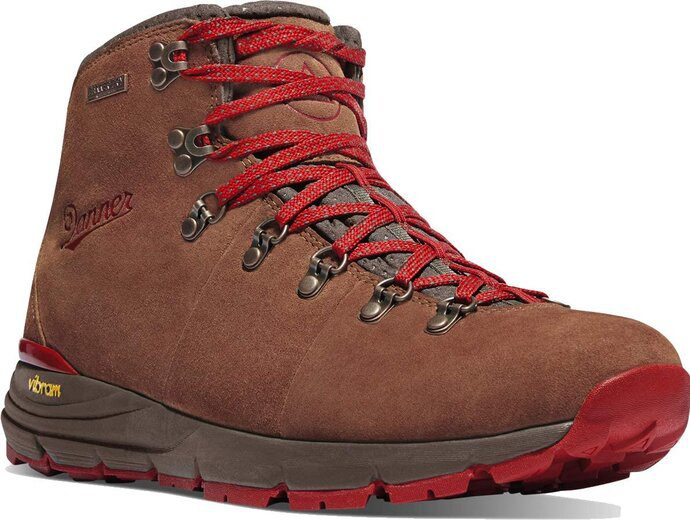
The Danner Mountain 600s are top-tier, serious mountain waterproof boots, boasting the best ankle support in their class.
They’re crafted with a fully waterproof suede upper and provide excellent waterproofing. However, these hiking shoes might be a bit much for just flat or well-trodden trails.
They’re best suited for hikers who frequently tackle tough mountain trails with rocky landscapes.
We’d heard a lot about the Megagrip technology in this model, so we put it to the test on several slippery slopes. To our pleasant surprise, the Vibram Fuga outsole offered impressive traction.
One thing to note, though, is that these boots are on the wider side. But, a thicker pair of socks should easily remedy that.
PROS
CONS
8) La Sportiva Ultra Raptor II Mid GTX
These high-traction nylon-mesh boots have a great rubber outsole, but the tread depth may come as disappointing for hikers on uneven or rocky terrain.

This hiking boot is a bit of a paradox. While a good grip on the soles is great for rocky surfaces, the rise of the boots offers less ankle support than other boots with similar tread.
In a review of La Sportiva Ultra Raptor II Mid GTX, we found in testing that it’s more than possible to step on a slant and get the traction to scale it but accidentally overextend your ankle where the best beginner hiking boots would support your ankle.
Further, because this boot’s weight is a bit lower than examples in the same class, it’s more than possible to turn these into trail runners on well-maintained trails if you are careful.
PROS
CONS
9) Adidas Terrex Swift R3 Mid GTX
Impressively breathable and flexible, I found walking just as comfortable as hiking in such a lightweight hiking shoe.

These boots offer a level of comfort that’s not typically expected from beginner hiking shoes.
In colder climates, on challenging terrains, or during steep hikes, these trail shoes might not be sufficient. However, they are an excellent choice for trail runners, straddling the line between hiking boots and athletic shoes.
The lug pattern on the rubber outsoles isn’t very deep, which is generally suitable for trail running.
Those with wide feet might struggle to find a comfortable fit, as these shoes tend to run small. While light and easy on the feet, they don’t offer much ankle stability for steep inclines.
One of the major advantages of these boots is their versatile design and the almost immediate comfort they provide without a break-in period. However, they are primarily intended for low-impact hiking.
If you’re planning to tackle rocky trails, these boots may not be the best fit for your needs.
PROS
CONS
How to Choose Beginner Hiking Boots
When choosing the best hiking shoes for beginners, we consider all of the following criteria and how they apply to most beginner hikers.
1. Comfort
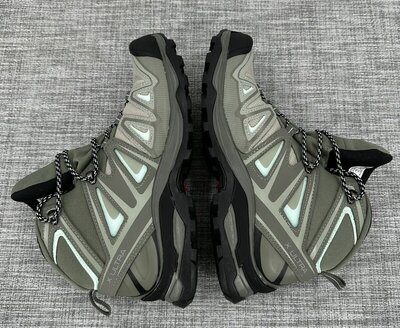
Remember, while comfort in your hiking gear and footwear is key from the start, most hiking boots tend to become more comfortable as time goes on.
When you’re choosing hiking shoes in the store, ensure they fit snugly but still allow your toes enough room to extend fully. With regular use, the boots will gradually mold to the shape of your foot, enhancing their fit.
And if you are planning on using your hiking shoes to trail run, you’ll certainly need top-quality lightweight boots for hiking that aren’t too stiff. That stiffness comes into play when you are hiking on surfaces where it’s easy to twist an ankle or lose your footing.
2. Cost

Don’t stretch your budget beyond comfort for a pair of boots.
However, remember that the best beginner hiking boots are an investment in your future hiking experiences.
In the realm of beginner hiking shoes, skimping to save a bit of money often doesn’t pay off.
My advice? Choose hiking shoes based on the features you need, without looking at the price tag first.
If the boots that tick all your boxes are above your budget, it’s perfectly okay to wait and save up for them. There’s no rush, and getting the right pair is worth the wait.
3. Fit
Ideal hiking boots for novices should fit comfortably without being so tight they rub and create blisters.
They’re crafted to secure the heel and stop your foot from sliding on uneven ground, something common footwear like sneakers can’t do. As a newcomer to the trails, aim for mid-cut boots that will hold your heel tight.
When trying to turn your foot inside the boot, you should feel a pushback. This is a positive indicator, showing the boot is up to the task of supporting your ankle to help avoid injuries if you trip or tumble.
4. Weight

Even the lightest hiking footwear will be heavier than regular shoes.
As a beginner, it’s a smart move to wear your new boots around the house for a couple of days before embarking on a challenging hike. This helps you adjust to the weight on your feet before you tackle tough terrains.
For most beginners, the best choice is a boot that falls in the middle weight range: not too light (under 1 lb) and not too heavy (over 4 lbs).
The ideal weight lies somewhere between these two, where you can discover your preference. Heavy boots are necessary in some scenarios, as lighter ones may not offer enough protection for activities like rock climbing or navigating uneven paths.
It’s generally not a good idea to sacrifice essential features in a hiking boot, such as a wide toe box or a sturdy over-the-ankle design, just for the sake of a lighter weight.
You’ll probably adapt to heavier boots over time, but lacking key features can significantly impact your hiking experience, whether you’re in shoes, boots, or trail runners.
5. Tread

Keep in mind that even lightweight hiking footwear tends to be heavier than your usual shoes.
For beginners, a good tip is to break in your new boots at home for a few days before hitting challenging trails. This practice will help you get accustomed to their weight.
If you’re just starting out, aim for boots that aren’t too light (below 1 lb) nor too heavy (above 4 lbs). The best option usually lies in this middle range.
This middle ground is where you’ll likely find the right balance. Heavy boots are essential for certain situations like rock climbing or uneven trails, where lighter boots might not provide adequate protection.
Compromising important features of a hiking boot, such as ample toe space or solid ankle support, for a lighter boot isn’t advisable.
While you may get used to the weight of heavier boots, missing out on these crucial features could seriously hinder your comfort and safety on hikes, regardless of the type of footwear you choose.
6. Ventilation

Ventilation is often at direct odds with waterproofing. You can’t let air into the boot without also letting in water.
Some advanced nylon shank boots are decent waterproof boots with ventilation, but this certainly isn’t the standard.
Expect your boot to do one or the other better.
Beginner hikers are more likely to need hiking boots with high ventilation because their feet are more likely to sweat.
And they may sweat even more in newer boots. There are premium hiking socks made to help overall ventilation, but when it comes to boots, it’s usually smarter to pick waterproofing over ventilation.
If you’re planning on winter hiking or using your hiking boots for backpacking trips or any kind of long-term trek or an overnight trip, you’re usually better off choosing superior waterproof hiking boots rather than other hiking shoes that are breathable.
7. Material
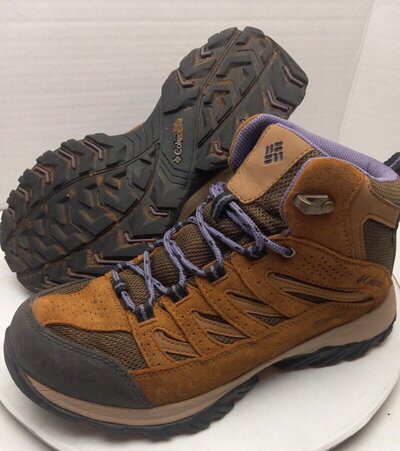
When starting out as a hiker, pay close attention to whether a hiking boot has steel reinforcement.
This reinforcement could be in the toe box or heel support, made from steel or other heavy metals, providing crucial protection against serious foot injuries.
For activities other than trail running, opting for steel-reinforced boots is usually a wise choice.
Though these boots are heavier, you’ll likely adapt to their weight more easily than recovering from a broken toe or a sprained ankle.
Another important material factor is the use of full-grain leather in hiking footwear.
If you’re vegan or oppose the use of animal products, it’s crucial to be vigilant. Many hiking boots are made with nubuck leather rather than synthetic alternatives. You might want to consult a vegan hiking community before choosing a leather boot.
8. Performance
Performance in hiking boots is measured by how quickly they reach their optimal condition and how long they maintain it.
A key indicator of a hiking shoe’s performance is its construction. High-quality hiking gear usually features thick rubber soles with an aggressive tread pattern and sturdy midsoles, making them suitable for technical terrains.
Gore-Tex waterproofing is a tell-tale sign of boots designed for tougher backpacking trails, especially useful for wet conditions.
However, if your hiking plans are more on the lighter side, you might not need all these features. It’s worth considering whether trail runners might be a more suitable choice for you than heavy-duty mountaineering boots.
Comparison Table
| BOOT | PRICE | WATERPROOF | WEIGHT |
|---|---|---|---|
| Salomon X Ultra 3 Mid GTX | Check on Amazon» | Yes, Gore-Tex | 2 lbs. 1.5 oz. |
| Merrell Moab 2 Mid WP | Check on Amazon» | Yes | 2 lbs. 2.6 oz. |
| Keen Targhee III Mid | $131 Backcountry» Check on Amazon» | Yes, Keen.Dry | 2 lbs. 2.8 oz. |
| Vasque Breeze Lt GTX Mid | Check on Amazon» | Yes, Gore-Tex | 1 lb. 10 oz. |
| Columbia Crestwood Mid WP | $84 Backcountry» Check on Amazon» | Yes | 1 lbs. 14 oz. |
| Lowa Renegade GTX Mid | $255 REI» $255 Backcountry» Check on Amazon» | Yes, Gore-Tex | 2 lbs. 7 oz. |
| Danner Mountain 600 | $190 Backcountry» Check on Amazon» | Yes | 2.10 lbs |
| La Sportiva Ultra Raptor II Mid GTX | $199 Backcountry» Check on Amazon» | Yes, Gore-Tex | 1 lb. 7 oz. |
| Adidas Terrex Swift R3 Mid GTX | $180 Backcountry» Check on Amazon» | Yes, Gore-Tex | 2 lbs. |
Tips to Help You Decide When Buying Your First Pair of Hiking Boots

The first pair of boots you choose could shape your preference for hiking footwear for years to come.
My top tip: Look for boots that fit your feet snugly while still giving them ample space.
Also, take your new boots for a spin around the block before embarking on any major adventures. This helps ensure comfort, especially when your feet inevitably swell during a hike.
Remember, hiking shoes are your safeguard out there. It’s seldom wise to prioritize a bargain over a proper fit. Be willing to invest in the right hiking shoes. A quality pair, even for beginners, can last decades with proper care.
FAQs
For beginners, mid-cut hiking boots are ideal because they deliver durable and versatile support. They offer solid ankle and heel support for most standard hikes and in colder weather. However, they may not be as effective on challenging mountain treks or uneven terrain.
As a beginner, having your own hiking boots is crucial. Trekking in sneakers or ill-fitting shoes is risky, as regular sneakers lack the necessary grip and ankle support. A slip on the trail while wearing them could lead to serious injury.
While lightweight hiking boots aren’t a must for beginners, they do bring benefits like less fatigue and more agility. The best choice depends on your preferences, but if you’re considering backpacking, trail runners could be a good alternative.
Trail runners often suit beginners better due to their comfort and adaptability. They’re well-suited for various terrains and activities, offering a good mix of hiking and running shoe features, perfect for those new to outdoor expeditions.


